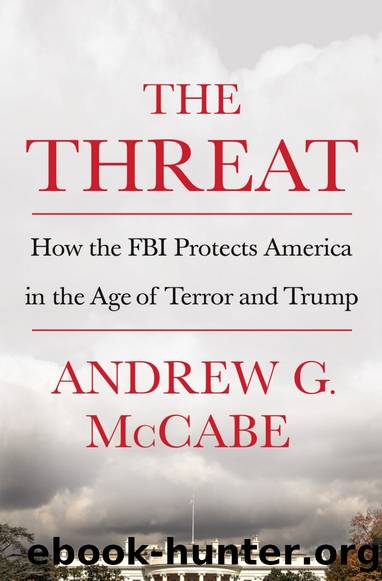The Threat: How the FBI Protects America in the Age of Terror by Andrew G. McCabe

Author:Andrew G. McCabe [McCabe, Andrew G.]
Language: eng
Format: epub
ISBN: 9781250207593
Google: F7tuDwAAQBAJ
Publisher: St. Martin’s Press
5
Benghazi to Boston
RELIVING THE HORROR, AGAIN AND AGAIN
No Red Lines
Try to hit the alligator closest to the boat. In 2011, when I returned to headquarters from the HIG, that was the counterterrorism divisionâs guiding strategy. And the water was teeming with alligators. As in the case of Zazi and the New York City subway plot, sometimes we got lucky. In May 2010, a Pakistani named Faisal Shahzad left a Nissan Pathfinder packed with propane, gasoline, fireworks, and timing triggers parked in Times Square. Vendors called the police when the car began smoking after a failed detonation. Three days later, Shahzad slipped past FBI surveillance teams outside his house and was pulled off a flight by Customs and Border Protection officers minutes before the airplane was to leave for Pakistan. In October of the same year, we were spared the loss of possibly two airliners when security officers found bombs packed in toner cartridges on aircraft at East Midlands Airport, in the United Kingdom, and Dubai International Airport, in the United Arab Emirates. Both packages were the creative and deadly work of AQAP bomb maker Ibrahim al-Asiri. In January 2011, observant workers discovered a backpack containing a radio-controlled pipe bomb on the route of the Martin Luther King Jr. Day parade in Spokane, Washington. Investigators determined that the perpetrator, a white supremacist named Kevin Harpham, had laced the bombâs shrapnel with rat poison to aggravate the injuries.
In September 2016, a man named Ahmad Khan Rahimi gave us three near misses in a single day. One Saturday morning, a bomb made by Rahimi detonated in a garbage can just before the start of a fun run in Seaside Park, New Jersey. No one was injured. That night, a pressure-cooker bomb made by Rahimi detonated on a street in Chelsea, in Manhattan, injuring a number of people but producing no fatalities. A second pressure-cooker bomb made by Rahimi, also left on the street in Manhattan, miraculously failed to detonate despite being handled and moved by several passersby. The next day multiple bombsâall the work of Rahimiâwere discovered at the train station in Elizabeth, New Jersey. Rahimi was taken into custody after a shootout with police in Linden, New Jersey.
Unfortunately, near misses were not our only experiences during those years. In Fort Hood, Texas, in Oak Creek, Wisconsin, in Overland Park, Kansas, in Chattanooga, Tennessee, in San Bernardino, California, in Orlando, Florida, terrorists killed or wounded many people. With each tragedy we improved our ability to respond and, we hoped, to prevent the next one. The inevitable next one. I had returned to CT during a milestone month of what I still nostalgically refer to as the âWar on Terror.â On May 2, 2011, U.S. forces killed Osama bin Laden. Though still a danger, al-Qaeda was no longer the monolithic, overriding threat it had once been. Counterterrorism now required thinking about a larger variety of extremist groups, including state-sponsored groups. Did Lebanonâs Hezbollah, or the Quds Force of Iranâs Revolutionary Guard Corps, have a presence in the U.
Download
This site does not store any files on its server. We only index and link to content provided by other sites. Please contact the content providers to delete copyright contents if any and email us, we'll remove relevant links or contents immediately.
| ASVAB | GED |
| GRE | NCLEX |
| PRAXIS | SAT |
| See more | Flash Cards |
| Study Guides | Study Skills |
| Workbooks |
Talking to Strangers by Malcolm Gladwell(13222)
The Compound Effect by Darren Hardy(8808)
Tools of Titans by Timothy Ferriss(8215)
Wonder by R. J. Palacio(8007)
The Lover by Duras Marguerite(7822)
A Court of Wings and Ruin by Sarah J. Maas(7648)
The Circle by Dave Eggers(7035)
Deep Work by Cal Newport(6877)
Kaplan MCAT General Chemistry Review by Kaplan(6866)
To All the Boys I've Loved Before by Jenny Han(5771)
Wiseguy by Nicholas Pileggi(5669)
The Body: A Guide for Occupants by Bill Bryson(4974)
1,001 ASVAB Practice Questions For Dummies by Powers Rod(4450)
Eat That Frog! by Brian Tracy(4432)
Cracking the GRE Premium Edition with 6 Practice Tests, 2015 (Graduate School Test Preparation) by Princeton Review(4224)
Pre-Suasion: A Revolutionary Way to Influence and Persuade by Robert Cialdini(4144)
Barron's AP Biology by Goldberg M.S. Deborah T(4096)
ACT Math For Dummies by Zegarelli Mark(3987)
Alive: The Story of the Andes Survivors by Piers Paul Read(3967)
